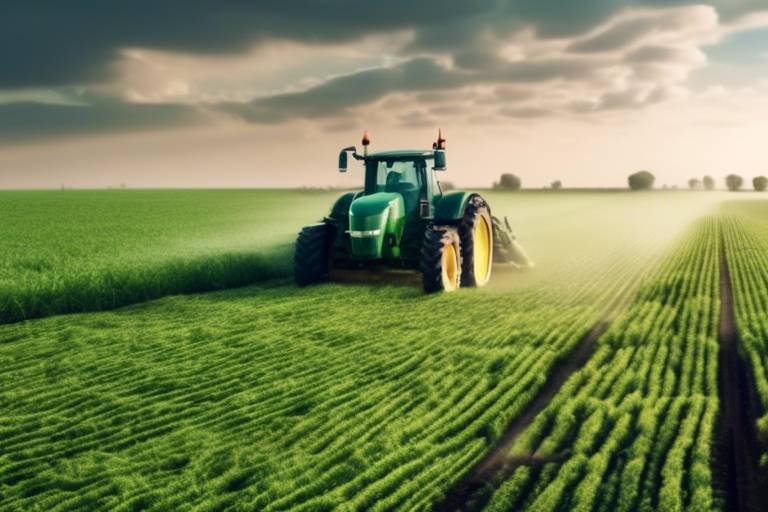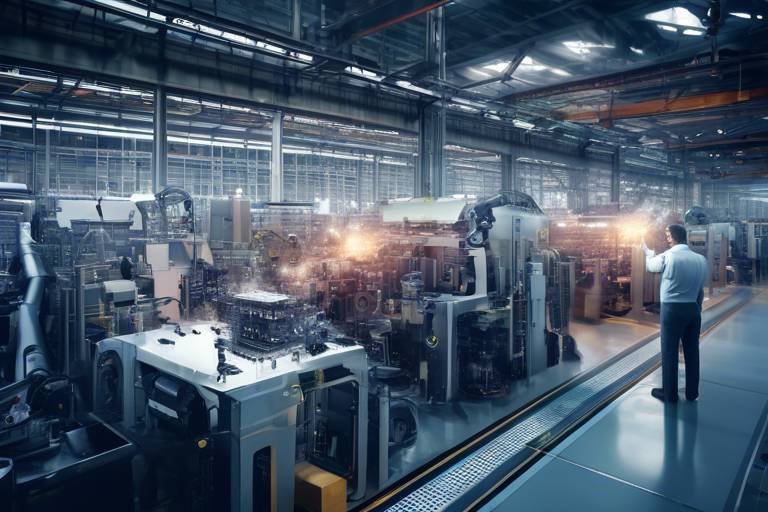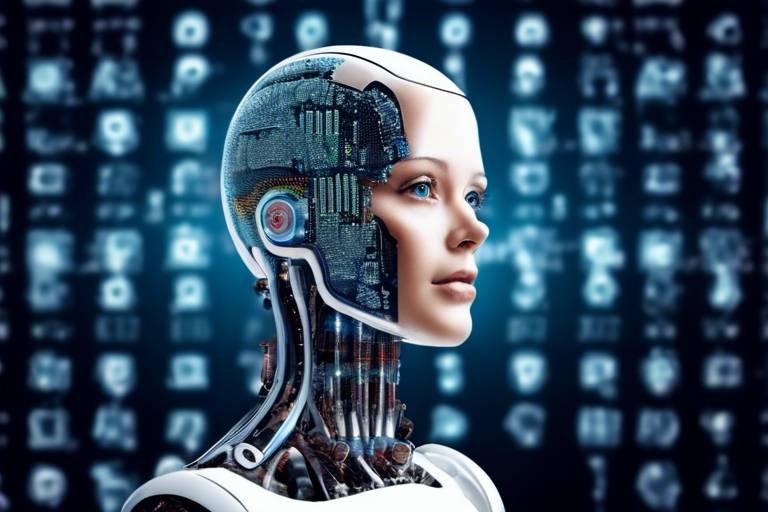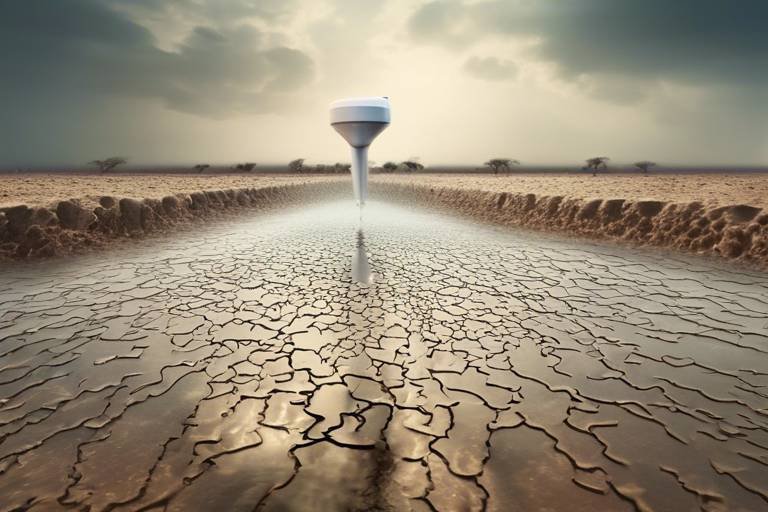The Potential of AI in Agriculture
In recent years, the agricultural landscape has started to shift dramatically, thanks to the incredible advancements in artificial intelligence (AI). Imagine a world where farmers can predict the exact moment to plant their crops, identify diseases before they spread, and optimize their resources to ensure maximum yield. This isn't just a dream; it’s the potential of AI in agriculture. By leveraging innovative technologies and data-driven solutions, AI is poised to revolutionize farming practices, enhance productivity, and promote sustainable agriculture. The integration of AI into agriculture isn't merely about technology; it’s about creating a future where both farmers and the environment can thrive together.
One of the most significant impacts AI has made in agriculture is through precision farming. This approach utilizes AI to analyze vast amounts of data collected from various sources, including sensors, satellite imagery, and weather forecasts. By doing so, farmers can optimize their crop yield and resource usage. For instance, AI algorithms can determine the best time to plant seeds, the ideal amount of water needed, and even the right fertilizer mix. This ensures efficient farming practices that not only minimize waste but also maximize productivity. Think of it as having a personal assistant dedicated to making your farming operations as efficient as possible.
Another exciting application of AI is in crop monitoring. With the help of drones and satellite imagery, AI-driven systems provide real-time insights into crop health. This technology allows farmers to monitor their fields from above, identifying issues like water stress or nutrient deficiencies before they escalate. Imagine being able to see your entire farm from the sky and make informed decisions on the go! With these insights, farmers can intervene when necessary, ensuring that crops receive the care they need at the right time.
AI tools are also transforming the way farmers approach pest and disease management. Early detection of pests and diseases is crucial for minimizing crop loss. Thanks to advanced image recognition and predictive analytics, AI can identify potential threats before they wreak havoc on crops. For example, by analyzing images of plants, AI can detect early signs of disease that might go unnoticed by the naked eye. This proactive approach allows farmers to take measures to protect their crops, ensuring a healthier harvest.
Understanding soil health is fundamental to successful farming, and AI is paving the way for better insights in this area. By utilizing AI for soil health analysis, farmers can gain a deeper understanding of their soil conditions. This leads to better crop selection and tailored fertilization strategies, which ultimately improve yields. Imagine knowing exactly what your soil needs to thrive, allowing you to make informed decisions that enhance productivity while also promoting sustainability.
AI is also making waves in supply chain optimization. By predicting demand and optimizing logistics, AI can help reduce waste and improve efficiency within agricultural supply chains. Farmers can manage their inventory better, ensuring they have the right amount of produce available at the right time. This not only boosts profitability but also contributes to reducing food waste, a critical issue in today’s world. Imagine a scenario where every piece of produce harvested is sold, thanks to efficient supply chain management!
The integration of AI into automated farming equipment is another game-changer. With AI, machines can perform tasks such as planting and harvesting with incredible precision. This not only increases efficiency but also significantly reduces labor costs. Picture a field where drones plant seeds with pinpoint accuracy, or robotic harvesters that can pick ripe crops at the perfect moment. This level of automation allows farmers to focus on strategic decision-making while the machines handle the heavy lifting.
AI empowers farmers through data-driven decision-making. With access to a wealth of data, farmers can make informed choices about resource allocation, crop rotation, and market trends. Imagine having a dashboard that provides insights into every aspect of your farming operation, helping you make decisions that enhance productivity and sustainability. This level of insight is invaluable, allowing farmers to adapt quickly to changing conditions and market demands.
As climate change poses new challenges, AI technologies are assisting farmers in adapting their practices. By providing forecasts and recommendations for climate-resilient agricultural practices, AI helps ensure that farmers can thrive even in unpredictable conditions. Think of AI as a weathered guide, helping farmers navigate the complexities of climate change and make adjustments that protect their livelihoods.
The future of AI in agriculture looks promising, with emerging trends that promise to further transform the industry. Advancements in machine learning, robotics, and sustainable farming practices are on the horizon. As these technologies evolve, farmers will have access to even more powerful tools that can enhance their operations. It’s an exciting time to be involved in agriculture, as the potential for innovation seems limitless.
- How does AI improve crop yields? AI analyzes data to optimize planting, watering, and fertilization, leading to increased crop yields.
- What role do drones play in agriculture? Drones provide real-time monitoring of crop health, helping farmers make informed decisions.
- Can AI help with pest management? Yes, AI can identify pests early through image recognition, allowing for timely intervention.
- Is AI in agriculture sustainable? By optimizing resources and reducing waste, AI contributes to more sustainable farming practices.

Precision Farming
When we think of farming, the image that often comes to mind is a vast field with a farmer working tirelessly under the sun. But in today’s world, where technology is rapidly evolving, is redefining what it means to cultivate crops. This innovative approach utilizes artificial intelligence (AI) to analyze vast amounts of data, allowing farmers to optimize their practices like never before. Imagine having a personal assistant that not only helps you understand your crops better but also suggests the best ways to enhance their growth. That’s precisely what AI brings to the table!
At its core, precision farming is about making informed decisions based on data rather than guesswork. By leveraging AI, farmers can gather insights on various factors such as soil quality, weather conditions, and crop health. This data-driven approach ensures that resources are used efficiently, minimizing waste while maximizing productivity. For example, instead of watering an entire field uniformly, AI can help determine which areas need more water based on real-time data, leading to significant savings on water and energy costs.
One of the most compelling aspects of precision farming is its ability to tailor farming practices to specific needs. Farmers can utilize satellite imagery and sensor technology to monitor crop conditions closely. This not only allows for better resource allocation but also helps in identifying potential issues before they escalate. For instance, if a farmer notices a decline in crop health in a particular section of their field, they can quickly investigate and apply targeted treatments, whether that’s adjusting irrigation or applying fertilizers. The result? Healthier crops and a more sustainable farming practice.
Moreover, precision farming isn't just about improving yields; it's also about protecting the environment. By using AI to analyze data, farmers can reduce the amount of pesticides and fertilizers they apply, leading to less chemical runoff and a healthier ecosystem. This approach aligns perfectly with the growing demand for sustainable agriculture, where the focus is on producing food without compromising the planet's health.
To illustrate the impact of precision farming, consider the following table that highlights the benefits:
| Benefit | Description |
|---|---|
| Increased Efficiency | Optimizes resource usage, reducing waste and costs. |
| Higher Yields | Improves crop health and productivity through targeted interventions. |
| Sustainability | Minimizes environmental impact by reducing chemical usage. |
| Data-Driven Decisions | Empowers farmers with actionable insights for better management. |
In conclusion, precision farming represents a significant leap forward in agricultural practices. By harnessing the power of AI, farmers are not only able to increase their productivity but also contribute to a more sustainable future. It’s like having a crystal ball that helps you see the future of your crops, enabling you to make decisions that lead to success. As we move forward, the integration of technology in farming will continue to evolve, making the possibilities endless.

Crop Monitoring
Crop monitoring is a game-changer in the agricultural landscape, and it’s all thanks to the power of artificial intelligence. Imagine being able to keep an eye on your crops from the comfort of your home, using advanced technology that analyzes every inch of your field. That’s precisely what AI-driven crop monitoring systems offer. By leveraging tools like satellite imagery and drones, farmers can gain real-time insights into the health of their crops, making it easier to spot issues before they escalate.
Think about it: traditional methods of crop monitoring often require farmers to walk their fields, which, while effective, can be time-consuming and labor-intensive. With AI, this process becomes streamlined. Drones equipped with high-resolution cameras can fly over vast expanses of farmland, capturing detailed images that AI algorithms analyze to detect any anomalies. This could include anything from nutrient deficiencies to pest infestations, allowing farmers to intervene early and effectively. The result? Healthier crops and better yields.
Furthermore, crop monitoring isn’t just about identifying problems; it’s also about understanding the overall health of the crops throughout their growth cycle. AI systems can analyze historical data alongside real-time information to predict how crops will respond to environmental changes, such as weather fluctuations or soil conditions. This predictive capability enables farmers to make informed decisions about irrigation, fertilization, and even harvesting schedules, optimizing their resources and maximizing productivity.
To illustrate the impact of AI in crop monitoring, let’s consider a few key benefits:
- Real-Time Data Access: Farmers can access critical information instantly, allowing for quicker responses to potential issues.
- Cost Efficiency: By identifying problems early, farmers can reduce the costs associated with crop loss and treatment.
- Improved Yield Predictions: With accurate data, farmers can make better forecasts about their harvests, helping them plan for market demand.
As we continue to innovate, the integration of AI in crop monitoring is only expected to grow. Farmers are increasingly adopting these technologies, and the results speak for themselves. The ability to monitor crops with such precision and efficiency not only enhances productivity but also promotes sustainable agricultural practices. After all, when farmers can manage their resources better, they contribute to a healthier environment and a more stable food supply.
In summary, AI-driven crop monitoring systems are revolutionizing how farmers approach crop management. By providing real-time insights and predictive analytics, these technologies empower farmers to make informed decisions that lead to healthier crops and improved yields. The future of agriculture is bright, and it’s all thanks to the incredible potential of artificial intelligence.
Q: How does AI improve crop monitoring?
A: AI enhances crop monitoring by analyzing data from drones and satellites to provide real-time insights into crop health, enabling early detection of issues like pests or nutrient deficiencies.
Q: What are the benefits of using drones in crop monitoring?
A: Drones offer high-resolution imaging and can cover large areas quickly, providing farmers with detailed data that helps them make informed decisions and respond to problems promptly.
Q: Can AI predict crop yields?
A: Yes, AI can analyze historical data along with real-time information to provide accurate predictions about crop yields, helping farmers plan better for market demand.
Q: Is AI crop monitoring expensive?
A: While there may be initial costs associated with implementing AI technologies, the long-term savings from increased efficiency and reduced crop loss often outweigh these expenses.

Pest and Disease Management
Pest and disease management is a critical aspect of modern agriculture, and with the advent of artificial intelligence, farmers now have powerful tools at their disposal to tackle these challenges head-on. Imagine waking up to a world where you can predict pest infestations before they even occur, or identify diseases in crops with just a snapshot taken from your smartphone. Sounds like science fiction, right? Well, it's becoming a reality thanks to AI technologies!
AI tools utilize image recognition and predictive analytics to detect early signs of pests and diseases, allowing farmers to act swiftly and effectively. For instance, by analyzing images of crops, AI systems can identify subtle changes that may indicate a problem. This means farmers can intervene before significant damage occurs, ultimately reducing crop loss and ensuring higher yields. Just think about it: instead of waiting for a pest outbreak to devastate your fields, you can be one step ahead, making timely decisions that protect your investment.
Furthermore, the integration of AI in pest management systems can lead to more sustainable practices. By accurately identifying the specific pests or diseases affecting crops, farmers can apply targeted treatments rather than blanket spraying pesticides. This not only minimizes chemical usage but also protects beneficial insects and the environment. It's a win-win situation for both farmers and nature!
To illustrate the impact of AI in pest and disease management, consider the following table that highlights the benefits of traditional methods versus AI-driven approaches:
| Aspect | Traditional Methods | AI-Driven Approaches |
|---|---|---|
| Detection Speed | Slow, often reactive | Fast, proactive |
| Pesticide Use | Broad-spectrum applications | Targeted treatments |
| Cost Efficiency | Higher costs due to crop loss | Lower costs, improved yields |
| Environmental Impact | Potentially harmful | More sustainable |
In addition to image recognition, AI systems can analyze vast amounts of data from various sources, including weather patterns, soil conditions, and historical crop performance. By correlating this information, AI can predict which pests or diseases are likely to emerge under specific conditions, giving farmers a crucial edge in their management strategies. It's like having a crystal ball that reveals the future of your crops!
Moreover, AI can facilitate collaboration among farmers. By sharing data on pest outbreaks and disease trends, farmers can create a community-based approach to pest management. This collective intelligence enables them to respond more effectively to threats and enhances overall agricultural resilience.
In conclusion, the role of AI in pest and disease management is not just about technology; it’s about transforming the way we think about farming. By embracing these innovations, farmers can safeguard their crops, protect the environment, and ensure a sustainable future for agriculture. So, are you ready to join the revolution and harness the power of AI in your farming practices?
- How does AI detect pests and diseases? AI uses image recognition technology to analyze pictures of crops, identifying early signs of pests or diseases that may not be visible to the naked eye.
- Can AI reduce pesticide use? Yes! AI allows for targeted treatments, which means farmers can apply pesticides only where necessary, significantly reducing overall chemical use.
- Is AI in agriculture cost-effective? Absolutely! By preventing crop loss and optimizing pest management, AI can lead to significant cost savings for farmers.
- How can farmers collaborate using AI? Farmers can share data regarding pest outbreaks and disease trends, creating a community approach that enhances pest management strategies.

Soil Health Analysis
Soil is the foundation of agriculture, and understanding its health is crucial for achieving optimal crop yields. With the advent of artificial intelligence (AI), farmers can now analyze soil health with unprecedented accuracy and efficiency. Imagine having a digital assistant that can tell you exactly what your soil needs—sounds like a dream, right? But it’s becoming a reality through AI-driven soil health analysis.
AI technologies can process vast amounts of data collected from various sources, including sensors, satellite imagery, and historical soil data. This data is then analyzed to provide farmers with insights into the nutrient levels, pH balance, and overall soil structure. By understanding these factors, farmers can make informed decisions about which crops to plant, how to fertilize, and when to irrigate. For instance, if the soil is found to be low in nitrogen, a farmer can apply the right amount of fertilizer at the right time, enhancing crop health while minimizing waste.
One of the most exciting aspects of AI in soil health analysis is its ability to offer tailored recommendations. Instead of a one-size-fits-all approach, AI can analyze the specific conditions of each field and suggest customized solutions. This is particularly beneficial for large-scale farms where soil conditions can vary significantly from one area to another. By employing precision agriculture techniques, farmers can optimize their resources and achieve better results.
To illustrate the benefits of AI in soil health analysis, consider the following table that compares traditional soil testing methods with AI-driven approaches:
| Aspect | Traditional Soil Testing | AI-Driven Soil Analysis |
|---|---|---|
| Time Required | Days to weeks | Real-time analysis |
| Data Collection | Manual sampling | Automated sensors and satellite data |
| Insights Provided | General nutrient levels | Detailed, actionable recommendations |
| Cost | Higher due to labor | Cost-effective through efficiency |
Moreover, AI can predict how soil health will change over time based on various factors, including weather patterns and crop rotation practices. By integrating this predictive capability, farmers can proactively manage their soil, ensuring it remains fertile and productive for years to come. This forward-thinking approach not only boosts farm productivity but also contributes to sustainable agriculture by reducing the overuse of chemical fertilizers and improving soil biodiversity.
As we look to the future, the role of AI in soil health analysis is bound to expand. Innovations such as machine learning algorithms and robotic soil sampling are just around the corner, promising even more precise and efficient solutions for farmers. In this ever-evolving landscape, staying informed and adapting to new technologies will be essential for farmers who wish to thrive in a competitive market.
- How does AI improve soil health analysis? AI enhances soil health analysis by providing real-time data, tailored recommendations, and predictive analytics that help farmers make informed decisions.
- Can AI help in sustainable farming practices? Yes, by optimizing resource usage and minimizing waste, AI contributes significantly to sustainable agriculture.
- What tools are commonly used for AI-driven soil analysis? Tools include sensors, drones, satellite imagery, and machine learning algorithms that analyze soil data.

Supply Chain Optimization
When we think of agriculture, we often picture vast fields and farmers toiling under the sun. However, the real magic happens behind the scenes, especially in the realm of supply chain management. In today's fast-paced world, optimizing the agricultural supply chain is crucial for ensuring that fresh produce reaches consumers efficiently and sustainably. This is where artificial intelligence (AI) steps in to revolutionize the process.
Imagine a farmer who can predict exactly when to harvest their crops based on real-time data analysis. AI technologies allow farmers to forecast demand accurately, which means they can plant the right amount of crops at the right time. This predictive capability reduces the risk of overproduction and waste, ensuring that every seed sown has a purpose. By analyzing historical sales data and current market trends, AI can provide insights that help farmers make informed decisions about what crops to grow and when.
Moreover, the logistics of getting products from the farm to the consumer are equally important. AI can optimize routes for delivery trucks, ensuring that goods arrive at their destination as fresh as possible. For instance, using machine learning algorithms, AI can analyze traffic patterns, weather conditions, and even road closures to determine the best delivery routes. This not only saves time but also reduces fuel consumption, contributing to a more sustainable approach to agriculture.
Furthermore, AI can help in managing inventory levels effectively. By integrating AI with inventory management systems, farmers and distributors can maintain optimal stock levels, reducing the likelihood of spoilage. For example, if a certain crop is predicted to be in high demand, AI can alert farmers to harvest more of that crop in advance, ensuring that supply meets demand without excess.
To illustrate the impact of AI on supply chain optimization, consider the following table:
| AI Application | Benefit |
|---|---|
| Demand Forecasting | Reduces overproduction and waste |
| Route Optimization | Ensures timely delivery and reduces fuel costs |
| Inventory Management | Maintains optimal stock levels and minimizes spoilage |
In addition to these benefits, AI can also enhance communication across the supply chain. By providing real-time updates on crop status, weather conditions, and market trends, all stakeholders—from farmers to retailers—can make better decisions. This transparency fosters collaboration, helping everyone in the supply chain to work together more effectively.
As we look to the future, it's evident that AI will continue to play a pivotal role in transforming agricultural supply chains. By leveraging innovative technologies, farmers can not only increase their productivity but also contribute to a more sustainable food system. The integration of AI into supply chain optimization is not just a trend; it's a necessary evolution in how we approach agriculture in a rapidly changing world.
In conclusion, the potential of AI in optimizing agricultural supply chains is immense. From predicting demand to streamlining logistics and enhancing communication, AI empowers farmers to make smarter decisions that benefit both their operations and the environment. As we embrace these technologies, we pave the way for a future where agriculture is not only productive but also sustainable.
- How does AI improve agricultural supply chains?
AI enhances supply chains by providing accurate demand forecasts, optimizing logistics, and managing inventory effectively. - What are the environmental benefits of using AI in agriculture?
AI reduces waste, minimizes fuel consumption, and promotes sustainable farming practices, contributing to a healthier planet. - Can AI help with pest management in supply chains?
Yes, AI can predict pest outbreaks and suggest preventative measures, ensuring that crops remain healthy throughout the supply chain.

Automated Farming Equipment
In the ever-evolving landscape of agriculture, stands out as a game-changer. Imagine a world where tractors autonomously navigate fields, planting seeds with pinpoint accuracy, and drones monitor crop health from above. This isn't just a dream—it's the reality that artificial intelligence is helping to create. The integration of AI in farming equipment not only boosts efficiency but also significantly reduces labor costs, allowing farmers to focus on what truly matters: growing healthy crops. With the rise of smart technologies, we are witnessing a transformation that could redefine the very essence of farming.
One of the most exciting aspects of automated farming equipment is its ability to perform tasks with incredible precision. For instance, consider the advancements in precision planting. AI-driven planters can adjust seed placement based on real-time data about soil conditions, moisture levels, and nutrient availability. This means that each seed is sown in the optimal environment, maximizing its chances of germination and growth. In addition, automated systems can monitor weather patterns and adjust their operations accordingly, ensuring that farmers are always one step ahead.
The benefits of using automated farming equipment extend beyond just planting. Take harvesting, for example. Modern harvesters equipped with AI technology can analyze crop readiness and determine the best time to harvest, which is crucial for maintaining quality and yield. These machines can also sort and process crops during harvesting, significantly reducing the time and labor required. This level of efficiency not only saves money but also minimizes waste, as crops are harvested at their peak.
Moreover, the data collected by these automated systems can be invaluable. Farmers can use insights gleaned from their equipment to make informed decisions about their operations. For instance, by analyzing yield data from previous seasons, farmers can adjust their planting strategies for the upcoming year. This data-driven approach leads to better resource allocation, improved crop rotation, and ultimately, enhanced profitability. The synergy between AI and automated farming equipment is paving the way for a more sustainable agricultural future.
As we look to the future, the potential of automated farming equipment will only grow. With advancements in robotics and machine learning, we can expect to see even more sophisticated tools that can adapt to changing conditions and learn from their environment. The integration of AI in agriculture is not just about efficiency; it's about creating a resilient ecosystem that can withstand the challenges posed by climate change and a growing global population.
In conclusion, the rise of automated farming equipment powered by AI represents a significant leap forward in agricultural practices. By embracing these technologies, farmers can enhance productivity, reduce costs, and promote sustainable farming methods. The future of agriculture is bright, and with the right tools, farmers can cultivate success like never before.
- What is automated farming equipment?
Automated farming equipment refers to machinery and tools that use technology, including AI, to perform agricultural tasks with minimal human intervention. - How does AI improve farming efficiency?
AI enhances farming efficiency by providing real-time data analysis, optimizing resource usage, and enabling precise operations such as planting and harvesting. - What are the benefits of using drones in agriculture?
Drones can monitor crop health, assess field conditions, and provide valuable data for decision-making, all while covering large areas quickly. - Can automated farming equipment reduce labor costs?
Yes, by automating routine tasks, farmers can significantly reduce the need for manual labor, leading to lower operational costs.

Data-Driven Decision Making
In the ever-evolving world of agriculture, has emerged as a game-changer for farmers seeking to enhance their productivity and sustainability. Imagine having the power to make informed choices that could significantly impact your yields and profits. With the integration of artificial intelligence (AI), farmers can now access a treasure trove of data that helps them understand their fields better than ever before.
At the heart of this revolution lies the ability to collect and analyze vast amounts of information. From weather patterns and soil conditions to market trends and crop performance, AI tools can process these variables to deliver actionable insights. For instance, a farmer can utilize AI algorithms to predict the optimal time for planting based on historical weather data and current climatic conditions. This not only maximizes crop yield but also minimizes the risks associated with unpredictable weather.
Moreover, AI empowers farmers to make decisions based on real-time data. Imagine standing in your field with a smartphone app that provides you with instant feedback on soil moisture levels, nutrient availability, and pest presence. This technology enables farmers to respond promptly to issues, ensuring that crops receive the care they need when they need it most. By leveraging data, farmers can also optimize their resource allocation, reducing waste and lowering costs.
One of the most significant advantages of data-driven decision making is its ability to facilitate precision agriculture. This approach allows farmers to tailor their practices to the specific needs of each section of their fields. For example, if a particular area of the field has lower soil fertility, farmers can apply targeted fertilization rather than blanket applications, which can lead to both cost savings and environmental benefits.
To illustrate the impact of data-driven decision making, consider the following table that outlines the benefits of AI in agriculture:
| Benefit | Description |
|---|---|
| Increased Efficiency | AI helps farmers optimize their operations, reducing time and resource wastage. |
| Enhanced Crop Yields | Data insights lead to better planting decisions, resulting in higher yields. |
| Cost Reduction | By optimizing inputs, farmers can significantly lower their operational costs. |
| Environmental Sustainability | Targeted practices reduce chemical runoff and promote soil health. |
Furthermore, data-driven decision making also extends to market insights. Farmers can analyze market trends and consumer preferences to determine which crops to plant for maximum profitability. This foresight allows them to stay ahead of the competition and align their production with market demands. Think of it as having a crystal ball that not only tells you what to plant but also when to harvest for the best price.
In summary, is not just a buzzword; it's a critical component of modern agriculture. By harnessing the power of AI and data analytics, farmers can make smarter choices that lead to improved productivity, sustainability, and profitability. As we continue to embrace these technologies, the future of agriculture looks brighter than ever.
- What is data-driven decision making in agriculture? It refers to the use of data analytics and AI tools to make informed decisions about farming practices.
- How does AI help in farming? AI analyzes data from various sources to provide insights that optimize crop yields, resource usage, and market strategies.
- Can small farmers benefit from data-driven decision making? Absolutely! AI tools are becoming increasingly accessible, allowing farmers of all sizes to leverage data for better outcomes.
- What are the long-term benefits of adopting AI in agriculture? Long-term benefits include increased efficiency, higher yields, reduced costs, and improved environmental sustainability.

Climate Adaptation
As the impacts of climate change become increasingly evident, the agricultural sector faces unprecedented challenges. Farmers are not just dealing with fluctuating weather patterns; they are also tasked with ensuring food security for a growing global population. This is where artificial intelligence steps in as a game-changer. By harnessing the power of AI, farmers can adapt their practices to be more resilient against climate-related challenges.
AI technologies provide valuable insights that help farmers understand and anticipate the effects of climate change on their crops. For instance, predictive analytics can forecast weather conditions, enabling farmers to plan their planting and harvesting schedules more effectively. Imagine having a weather oracle that tells you exactly when to sow your seeds or when to prepare for a storm—this is the kind of foresight AI offers!
Moreover, AI can analyze vast amounts of data from various sources, including satellite imagery and local weather stations, to identify trends and patterns. This data-driven approach allows farmers to make informed decisions about which crops to plant based on projected climate conditions. For example, if a region is expected to experience prolonged drought, farmers can opt for drought-resistant crop varieties that require less water, thus ensuring a better yield even in adverse conditions.
Additionally, AI can assist in developing sustainable agricultural practices that are not only profitable but also environmentally friendly. By optimizing water usage, reducing fertilizer runoff, and minimizing pesticide applications, farmers can lessen their ecological footprint. For instance, AI systems can monitor soil moisture levels in real-time, advising farmers on when to irrigate, which can significantly conserve water resources.
Here’s a quick look at how AI contributes to climate adaptation in agriculture:
| AI Application | Benefits |
|---|---|
| Predictive Analytics | Forecasts weather patterns to optimize planting and harvesting schedules. |
| Data Analysis | Identifies trends in climate data for informed crop selection. |
| Soil Monitoring | Provides real-time data on soil conditions, improving irrigation and fertilization practices. |
| Resource Optimization | Reduces waste through precise application of water and fertilizers. |
In summary, the integration of AI in agriculture is not just about improving yields; it's about creating a sustainable future where farmers can thrive despite the challenges posed by climate change. As we continue to innovate and adapt, the agricultural landscape will transform, ensuring that we can feed the world while preserving our planet for future generations.
- What role does AI play in climate adaptation for agriculture?
AI helps farmers analyze climate data, predict weather patterns, and optimize crop management practices to enhance resilience against climate change. - Can AI help in selecting crops for changing climates?
Yes, AI can assess environmental conditions and historical data to recommend the best crop varieties suited for future climate scenarios. - How does AI contribute to sustainable farming practices?
AI optimizes resource use, such as water and fertilizers, reducing waste and minimizing environmental impact. - Is AI technology accessible to small-scale farmers?
Many AI solutions are becoming more affordable and user-friendly, making them increasingly accessible to farmers of all sizes.

Future Trends in AI Agriculture
Exploring how artificial intelligence can revolutionize farming practices, enhance productivity, and promote sustainable agriculture through innovative technologies and data-driven solutions.
Precision farming utilizes AI to analyze data for optimizing crop yield and resource usage, ensuring efficient farming practices that minimize waste and maximize productivity.
AI-driven crop monitoring systems leverage satellite imagery and drones to provide real-time insights into crop health, enabling farmers to make informed decisions and intervene when necessary.
AI tools help identify pests and diseases early through image recognition and predictive analytics, allowing farmers to take proactive measures and reduce crop loss.
Utilizing AI for soil health analysis enhances understanding of soil conditions, leading to better crop selection and tailored fertilization strategies for improved yields.
AI can streamline agricultural supply chains by predicting demand, optimizing logistics, and reducing waste, ultimately improving efficiency and profitability for farmers.
The integration of AI in automated farming equipment increases efficiency, reducing labor costs and improving precision in tasks such as planting and harvesting.
AI empowers farmers with data-driven insights, enabling them to make informed decisions about resource allocation, crop rotation, and market trends.
AI technologies assist farmers in adapting to climate change by providing forecasts and recommendations for climate-resilient agricultural practices.
The future of AI in agriculture is as exciting as it is transformative. As technology evolves, we can expect a wave of innovations that will further enhance farming practices and sustainability. One of the most significant trends is the rise of machine learning algorithms that can predict not just crop yields but also market fluctuations, allowing farmers to make decisions that are both timely and profitable. Imagine having a digital assistant that can analyze vast amounts of data and provide tailored recommendations specific to your farm's unique conditions!
Moreover, advancements in robotics are set to revolutionize the way we approach farming. From autonomous tractors to drones that can plant seeds, the integration of robotics with AI will lead to greater efficiency and reduced labor costs. These machines can operate around the clock, ensuring that crops receive the care they need without the limitations of human labor.
Another trend to watch is the development of sustainable farming practices driven by AI. By analyzing data on soil health, weather patterns, and crop performance, AI can help farmers implement practices that not only increase yields but also protect the environment. For instance, AI can suggest optimal planting times and crop rotations that enhance soil fertility and reduce the need for chemical fertilizers.
Furthermore, the use of blockchain technology in conjunction with AI is gaining traction. This combination can enhance transparency in the supply chain, ensuring that consumers know where their food comes from and how it was produced. It can also help farmers track their products from field to market, minimizing waste and ensuring fair pricing.
As we look ahead, it's clear that the intersection of AI and agriculture will continue to evolve. The potential for smart farming solutions that leverage big data, IoT (Internet of Things), and AI is immense. Farmers will not only be able to increase productivity but also contribute to a more sustainable food system. The future is bright, and the possibilities are endless!
- What is AI in agriculture?
AI in agriculture refers to the use of artificial intelligence technologies to enhance farming practices, improve crop yields, and promote sustainability. - How does AI improve crop monitoring?
AI improves crop monitoring by using satellite imagery and drones to provide real-time insights into crop health, allowing farmers to make informed decisions. - Can AI help with pest management?
Yes, AI tools can identify pests and diseases early through image recognition, enabling proactive measures to minimize crop loss. - What are the benefits of precision farming?
Precision farming optimizes resource usage, minimizes waste, and maximizes productivity by analyzing data for better farming practices. - How does AI contribute to sustainable agriculture?
AI contributes to sustainable agriculture by providing insights that help farmers adopt practices that protect the environment while increasing yields.
Frequently Asked Questions
- What is precision farming and how does AI contribute to it?
Precision farming is a modern agricultural practice that uses AI to analyze vast amounts of data to optimize crop yield and resource usage. By leveraging data from various sources, such as weather patterns and soil conditions, AI helps farmers make informed decisions that minimize waste and maximize productivity. Imagine having a personal assistant that knows exactly when to water your plants or when to apply fertilizers—this is what AI brings to the table!
- How does AI assist in crop monitoring?
AI enhances crop monitoring by utilizing advanced technologies like satellite imagery and drones. These tools provide real-time insights into crop health, allowing farmers to detect issues early on. Think of it as having a bird's-eye view of your farm; you can spot problems before they escalate, enabling timely interventions that can save your harvest.
- Can AI help with pest and disease management?
Absolutely! AI tools employ image recognition and predictive analytics to identify pests and diseases at their early stages. This proactive approach allows farmers to take necessary actions before significant damage occurs. It's like having a vigilant watchdog on your farm, alerting you to any threats before they wreak havoc on your crops.
- What role does AI play in soil health analysis?
AI plays a crucial role in understanding soil conditions by analyzing data related to soil health. This knowledge leads to better crop selection and tailored fertilization strategies, ultimately resulting in improved yields. Imagine knowing the exact nutrients your soil craves—AI makes this possible, ensuring your crops thrive.
- How can AI optimize agricultural supply chains?
AI can streamline agricultural supply chains by predicting demand, optimizing logistics, and reducing waste. This means farmers can efficiently manage their produce from farm to table, ensuring that food reaches consumers while it's still fresh. Think of it as having a smart route planner that helps you avoid traffic—AI helps farmers avoid waste and maximize profits!
- What are the benefits of automated farming equipment powered by AI?
The integration of AI in automated farming equipment boosts efficiency and reduces labor costs. Tasks like planting and harvesting become more precise, allowing farmers to focus on other important aspects of their operations. It's like having a team of highly skilled robots working tirelessly to ensure your farm runs smoothly!
- How does AI facilitate data-driven decision making in agriculture?
AI empowers farmers with valuable insights derived from data, enabling informed decisions about resource allocation, crop rotation, and market trends. With AI, farmers can analyze patterns and make strategic decisions that enhance productivity and profitability. It's akin to having a crystal ball that reveals the best path forward for your farming business.
- In what ways can AI help farmers adapt to climate change?
AI technologies assist farmers in adapting to climate change by providing forecasts and recommendations for climate-resilient agricultural practices. This means farmers can make informed choices about which crops to plant based on changing weather patterns, ensuring sustainability and resilience in their operations. Think of AI as your personal climate advisor, guiding you through the unpredictable weather of farming!
- What are some future trends in AI agriculture?
Emerging trends in AI technology promise to further transform agriculture, including advancements in machine learning, robotics, and sustainable farming practices. These innovations will likely enhance efficiency, reduce environmental impact, and improve the overall quality of agricultural products. It's an exciting time for farming, as technology continues to evolve and reshape the industry!


















